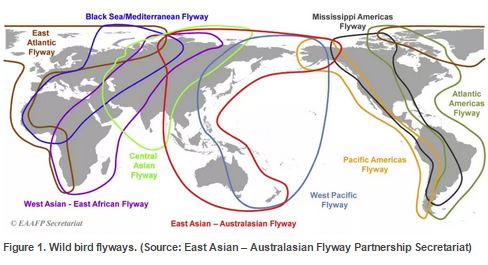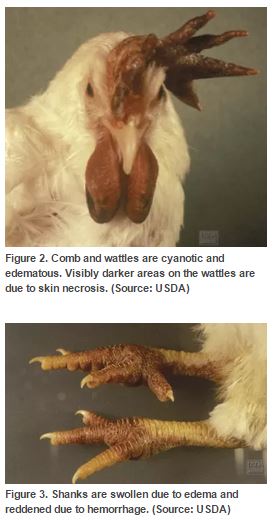



Rigorous Surveillance Imperative to Prevent Spread of Avian Influenza
Poultry producers should become more familiar with avian influenza (AI) subtypes to avoid being blindsided by this devastating disease, say Jose A. Linares (Technical Director, Global Poultry) and Dan T. Domingo (Director, Global Diagnostic Medicine, Poultry) from Zoetis Inc.The enormous economic threat that avian influenza (AI) poses to the global poultry industry, coupled with its potential for evolution into zoonotic forms that threaten people, underscore the need for rigorous surveillance to curtail spread of the disease, wrote the two veterinarians in an exclusive article for Poultry Health Today.
Since 2011, the United Nations Food and Agriculture Organisation has considered Bangladesh, China, Egypt, India, Indonesia and Vietnam to be endemic for Asian-origin highly pathogenic AI H5N1 virus in poultry. Canada and the US started experiencing significant outbreaks of highly pathogenic H5N2 after December 2014. AI has also been detected in several European countries, including Germany, the Netherlands, the United Kingdom and Italy.[1]
The current wide geographical distribution of active AI outbreaks and the already established endemic areas indicate that outbreak control in the immediate future is unlikely, and the disease must be considered a serious risk to poultry flocks around the world.
Because AI can affect all types of commercial poultry, it is important for everyone involved in the industry to understand its origin, recognize which commercial flocks are most vulnerable and know how AI viruses are classified.
Wild birds are the natural hosts for AI viruses. In fact, AI has been isolated from more than 100 different species of wild birds around the world, particularly shorebirds and ducks. Wild birds usually don’t become ill from AI viruses, but they excrete large amounts of the viruses in their feces, which is then disseminated along their migration routes.
The risk of commercial poultry contracting AI is, therefore, greater in flocks located along wild-bird migratory routes (Figure 1) or close to bodies of water where migrating wild birds congregate.
Another risk for AI involves live-bird markets, where a variety of birds, such as ducks and chickens from multiple locations, come into close contact, enabling the adaptation of the virus to new host species and transmission of the disease.
Classification
All AI viruses are categorised as Type A influenza viruses. Each is then subtyped based on two main classes of surface proteins known as hemagglutinin and neuraminidase.
AI viruses are also classified as low pathogenic or highly pathogenic. Pathogenicity is determined by molecular characteristics and the ability to cause disease and mortality in poultry.
Two subtypes of note are H5 and H7. Although H5 and H7 viruses can be low pathogenic, they are the only two subtypes known to have mutated into highly pathogenic forms.
Even if they are highly pathogenic and pose a significant threat to poultry, not all of them threaten people.[2] For instance, the highly pathogenic H5N1 version of AI that originated in Asia is devastating for poultry and has affected humans.
However, a recently isolated North American H5N1 is highly pathogenic in poultry but is considered of little risk to people.[3]
A moving target
Our intention is not to cause alarm, but we must apply the lessons from history and remind the poultry industry that AI has the ability to transform. AI viruses can mutate, which means that a particular AI virus changes itself, or it can undergo reassortment, which occurs when two or more AI viruses exchange genetic material.
The highly pathogenic Asian H5N1 that’s a threat to poultry and people is a triple reassortant. The highly pathogenic H5N2 currently circulating in the US is a reassortant of Eurasian H5N8 and North American viruses.
Although some AI subtypes are low pathogenic, the risk of them contributing to the emergence of new viruses increases the longer they circulate. Low pathogenic viruses can undergo reassortment with H5 and H7 subtypes. A case in point is H9N2, now endemic in Asia and North Africa.
This particular H9N2 virus “donated” its internal genes to AI viruses in Asia, such as H5N1 and H7N9, that are a threat to people. It is important to note that in poultry, H5N1 is highly pathogenic and H7N9 is of low pathogenicity.
With genetic sequencing, we can identify low-pathogenic H5 and H7 AI viruses that are unlikely to transform into highly pathogenic forms, but we can also tell there are low-pathogenic H5 and H7 AI viruses that are just a few changes away from changing (or mutating) into highly pathogenic forms.
The sooner AI viruses can be detected, characterised and the riskiest forms identified, the greater the chances are that we can take measures to prevent their spread. This requires all of us in the poultry industry to understand the value of routine AI surveillance.
Identifying AI
Clinically, highly pathogenic AI is generally easy to identify because it’s likely to strike without warning and causes very high mortality. Your birds can look fine one day and all be dead the next
Birds that survive the infection normally develop lesions consistent with vascular damage such as edema and necrosis (Figure 2) or reddened shanks due to hemorrhage (Figure 3). Other birds develop neurological signs such as twisting of the neck.
The low-pathogenic form of AI is more difficult to identify clinically and differentiate from other respiratory problems such as Mycoplasma. Most birds will have respiratory signs. Egg production in layers and breeders will drop. Sometimes, the kidneys or pancreas are affected. Mortality in these flocks might be around 5 per cent.
Regulations and procedures for testing flocks for AI vary among countries and with the type of birds being monitored. As an example, we’ll cite general procedures in the US, where producers voluntarily follow routine serological AI surveillance programs reviewed and approved by the National Poultry Improvement Plan:
- Breeding stock is tested when they are more than 4 months of age, prior to moving to the lay house, at 90-day intervals thereafter and prior to disposal/slaughter.
- Table egg layers are also tested when they are more than 4 months of age, prior to moving to the lay house, at 90-day intervals thereafter and prior to disposal/slaughter.
- Broiler chickens and turkeys are tested prior to slaughter.
Again, depending on the country, surveillance may be more intense if AI is confirmed in a flock or area, especially if it’s a highly pathogenic form.
Countries with a “stamp-out infection” plan or zero tolerance for AI require quarantines and elimination of AI-positive flocks. All other flocks are monitored with increased testing to ensure they remain AI-free.
The intensity of surveillance varies, depending on whether flocks are in the infected zone — within at least 3 km or 1.86 miles from an infected premise — or the control zone — which is an area that is at least 10 km or 6.2 miles from an infected premise. Additional testing may also be implemented in flocks within a surveillance zone surrounding the control zone.
In some countries where AI is endemic and the infection can’t be eliminated, routine testing and strict biosecurity in breeders may be required. Vaccination may be the primary method of control for egg layers and broilers.
In these instances, routine serology testing may not be used to diagnose infection because it’s difficult to determine if antibodies are due to AI vaccination or a field virus.
Test kits
The availability of various on-farm AI test kits varies worldwide, but one example is FluDETECT® Avian (from Zoetis), which will reveal the actual presence of AI virus in about 15 minutes.
It is used primarily for screening or for detecting the virus in active or acute infections and is recommended for use in birds that are sick or when dead birds are found and AI is suspected. Oropharyngeal/tracheal or cloacal swab samples are used for the test, which detects all 16 H subtypes of Type A influenza.
The ProFLOK® AIV Ab kit (from Zoetis) is an ELISA test that detects antibodies produced by all H subtypes of AI. It will indicate when a flock has been exposed to the AI virus. Because it detects antibodies, the infection may have passed and the virus may not be detectable using antigen-capture assays.
Samples can be taken from sick birds with respiratory signs or from birds that appear healthy. This test is performed in a laboratory setting and can also be used for quantifying antibody titres, which will demonstrate the immune response in birds that have been vaccinated against AI.
FluDETECT® BE (from Zoetis) is another antibody ELISA test performed in a laboratory setting that can be used for routine surveillance. It is a blocking ELISA (hence, the BE), and is therefore only a qualitative test, which means it simply provides a positive or negative result.
FluDETECT BE can be used for testing commercial poultry but is more often used to test wild birds.
Anytime one of these or another AI test is positive, additional samples should be taken for confirmation of the diagnosis and for virus isolation and characterisation. While awaiting laboratory confirmation of AI infection, biosecurity measures must be implemented.
These include restricting the movement of poultry, equipment and people who have been in any facilities thought to be positive for AI. All poultry producers should have predetermined response procedures in place, based on their country’s regulations, if a flock tests positive for AI.
We should note here that although biosecurity procedures are imperative for preventing and controlling AI in commercial poultry flocks, they are not foolproof and may break down, which is another reason routine surveillance of AI is so important.
Final thoughts
In summary, control of AI in the short term is unlikely, and the disease is going to remain a constant risk for the poultry industry.
Protecting commercial poultry from avian influenza requires keeping flocks physically separate from wild birds and adhering to other standard biosecurity procedures. Biosecurity is not foolproof, so routine surveillance, prompt identification of subtypes and appropriate control measures are imperative if the global poultry industry is to contain AI.
To avoid being blindsided by this devastating disease, producers are encouraged to have local, regional and global awareness of the avian influenza subtypes that are circulating in wild birds and commercial poultry.
[1] European Commission. http://ec.europa.eu/food/animal/diseases/controlmeasures/avian/
Accessed May 13, 2015.
[2] Avian Influenza Current Situation. http://www.cdc.gov/flu/avianflu/avian-flu-summary.htm
Accessed May 5, 2015
[3] Ibid.














